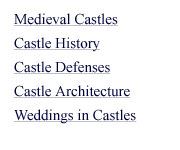|
Castle Defenses
Medieval
Castle Sieges
Medieval sieges could last for months.
Attacking armies would set up long-term encampments at a safe
distance from the castle's long-range catapults and crossbows.
The attackers would also try to cut off as many points of
access to the castle as possible and often built palisade
fences for their own protection.
Sieges involved both covert and overt action.
While heavy weapons such as battering rams, catapults, trebuchets
and towers were trying to breach the walls, the most devastating
attacks often came from underneath. Medieval miners had a
very dangerous job during a siege. These men would find a
weak point in the castle's wall, and tunnel under the foundation,
preferably at a corner. After they had dug to their goal,
loads of dry wood and brush were used to fill the tunnel cavity.
Everyone would exit, and the last miner would set the fuel
on fire. The strategy was, the blaze would cause the tunnel
to collapse causing castle walls to fall, or be damaged enough
to further exploit the weakness. Defending armies tried to
detect miners' efforts using buckets of water. The castle
army would start digging its own tunnels to counter the miners'
efforts. If these tunnels ever connected, fierce hand-to-hand
combat would soon ensue.
Attacking armies tried to take castles
in stages. A common plan of attack involved first taking the
gatehouse, then the castle's bailey, followed by its towers
and the keep. Hand -to hand combat meant heavy losses would
be suffered one both sides.
Sieges also ended from treachery amongst
the defending castle garrison. Attacking commanders tried
to exploit truces, and use the opportunity to plant a spy
within the castle walls. A defending army defector might have
been someone who wanted safe conduct and a purse of gold.
This would be his price for information on weak points, or
how to breach the castle walls.
Defending castles usually surrendered from
lack of supplies. Food, water, ammunition, leather, iron and
other necessities would be used during the weeks an months
of a siege, and the fortress became more a prison than protector.
Water sources were especially vulnerable. Wells were a necessity
in medieval castles but they often failed and attackers would
cut off any outside water supply or poison them if possible.
|










